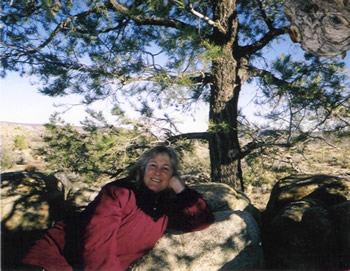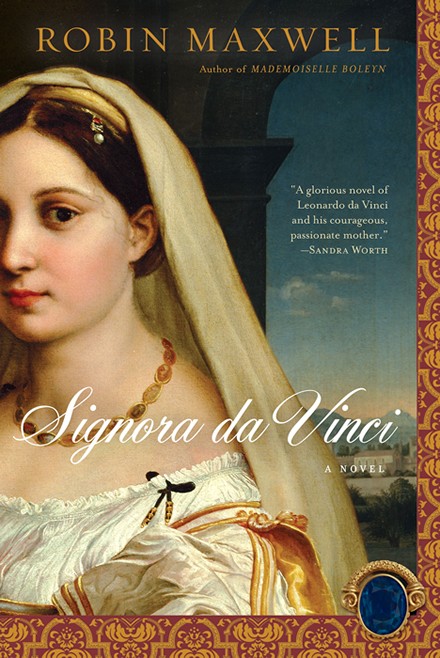You’ve written six novels about 15th and 16th century England and Ireland. What possessed you to abandon the Tudors and head south to Renaissance Italy?
I feel that, for now, I’ve “written myself out” with the most fascinating individuals of that most fabulous and colorful place and time. I always insist on being, if not the first to write about a given character (nearly impossible with such well-known figures) then having a strong and wholly original “angle” or “hook” for my story: Elizabeth I and Robin Dudley’s illegitimate son in The Queen’s Bastard; the intimate mother/daughter connection from beyond the grave in Secret Diary of Anne Boleyn; and the early lives of Anne and Mary Boleyn at the erotic French court in Mademoiselle Boleyn.
For some time I’d been intrigued by the ridiculously fertile mind and staggering accomplishments of Leonardo Da Vinci. Long before The Da Vinci Code, he was a firmly entrenched icon in human culture and consciousness, but my research piled mystery upon mystery about this polymath genius. However, Leonardo was so obsessively secretive about his personal life, and was such a success in that regard, that with all his thousands of pages of notebooks and various works of art, invention, science, architecture and philosophy, very little was revealed about Leonardo the person.
And while we do know something about Da Vinci’s father, Piero – his social climbing and business successes, his almost inhuman coldness to his bastard son, and his struggle to sire legitimate children – we know next to nothing about Da Vinci’s mother. By my own simple logic I deduced that Piero, while an intelligent and resourceful man, never displayed an ounce of creativity, that divine spark that utterly defined Leonardo.
That would, of course, leave his mother as the donor of the “genius genes.” But of the woman who gave birth to one of the world’s most remarkable minds we possess exactly two facts: 1) Her name was Caterina. 2) Leonardo was taken from her the day after his birth to be brought up, as a bastard, in the Vinci home of Piero’s father, Antonio.
Virtually everything else is conjecture. What I can (and did) imagine is how any woman would feel having her child ripped from her arms one day after he was born, knowing that the household he was going to be raised in would be an unloving one.
*Was it a stretch to create an entire novel around a woman with so little history?
All of my research added up to an enormous hole in a most fascinating period, within the life of its most compelling personage. As the writer of historical fiction, these gaping chasms are what I live for. They provide a rare opportunity to create something from little or nothing. I am happily forced to take the tiniest cluster of cells, no larger than a fetal blastula, examine the medium in which it develops, the world into which it is born and grows, its ancestors and associates, until it blossoms into a living, breathing, thinking, feeling human being. With so little known about Caterina, the sky was the limit.
Because I had chosen that she was the parent responsible for not only Leonardo Da Vinci’s brilliance, but his sweet temperament and supreme open-mindedness, I was free to give her the best qualities a woman could possibly have. I made her the mother that every child deserves to have – one who, without becoming a martyr, would do anything and everything to protect that child, shower him with love and tenderness, and provide him with every possible opportunity.
Happily for me, what began as sacrifices Caterina made for Leonardo, turned into the greatest adventure a woman in fifteenth century Italy could imagine in her wildest dreams. Disguising herself as a man, being accepted into the Platonic Academy, becoming the lover of Lorenzo the Magnificent, meeting and conspiring with the greatest minds of the times, were not only boons to Caterina’s character arc, but they were doorways into the topics that I was keen to explore in a book about the period.
*You rarely see Lorenzo’s de'Medici's name tied with Da Vinci’s. Yet in Signora Da Vinci, Lorenzo acts as Leonardo’s “godfather.”
Lorenzo’s tie with Leonardo is pondered in some detail by historians. Some say the maestro was ignored by Il Magnifico, who felt the lowborn artist was “below him socially.” Others go so far as to suggest that Leonardo – like Michelangelo after him – was actually housed for a time in the Palazzo Medici and treated as a son.
While there’s little evidence that the artist lived in the Florence palace, I find it hard to believe that Lorenzo would not have held the insanely talented young man, apprentice to the family’s own court artist, Andrea Verrocchio, in very high regard.
And I believe that in 1484 Leonardo’s leave-taking from Florence for Milan, to the court of Lorenzo’s friend, Ludovico Il Moro, was a well-planned move, probably to protect the well-known heretic and necromancer (scandalized by his sodomy trial) from the worsening religious persecutions he would certainly have suffered had he stayed. Too, Lorenzo was such a man-of-the-people that I cannot imagine him snubbing Leonardo simply because he hadn’t been born noble.
*How plausible is it that a woman could successfully live as a man, as Caterina does in Signora Da Vinci?
Cross-dressing in history has always interested me, especially women who have taken on the guise of a men. The nearly unbelievable examples are females who have put on soldiers’ garb and gone to war for extensive periods, serving on the battlefield with male comrades, only being found out after their deaths.
Caterina, living alone as she does in my story, had it easier. It was my creative choice to have her menstrual cycle disrupted when, through misery, she lost a great deal of weight after Leonardo departed for his apprenticeship in Florence. This simplified certain parts of her existence. My favorite tidbit of historical research on the subject was the “horn” that cross-dressing women used to have a normal-looking male piss in public.
Certainly one needs readers who enjoy a “suspension of disbelief” in this regard, but not only was Caterina’s disguise possible, such behavior was commonplace enough to have several books written about it (refer to my Acknowledgments).
 Thank you Robin! And feel free to visit Robin Maxwell online for more information about her latest novel Signora Da Vinci. As I wrote in the blurb for your book, this is one of the best historical novels I read in 2008!
Thank you Robin! And feel free to visit Robin Maxwell online for more information about her latest novel Signora Da Vinci. As I wrote in the blurb for your book, this is one of the best historical novels I read in 2008!
#
Posted by Michelle Moran @ | 6:15 PM






 Thank you Robin! And feel free to visit Robin Maxwell online for more information about her latest novel Signora Da Vinci. As I wrote in the blurb for your book, this is one of the best historical novels I read in 2008!
Thank you Robin! And feel free to visit Robin Maxwell online for more information about her latest novel Signora Da Vinci. As I wrote in the blurb for your book, this is one of the best historical novels I read in 2008!







